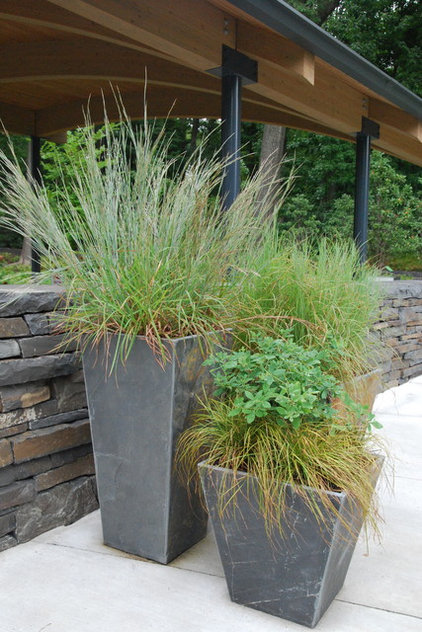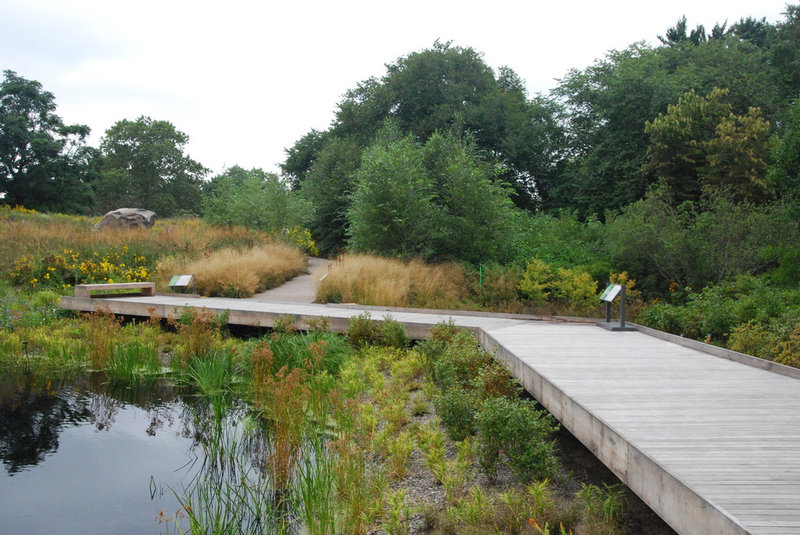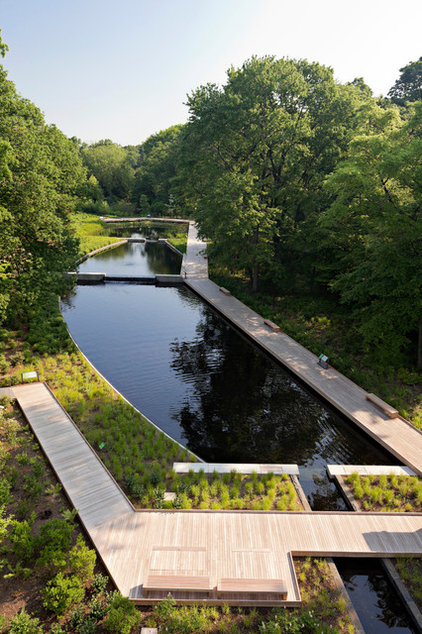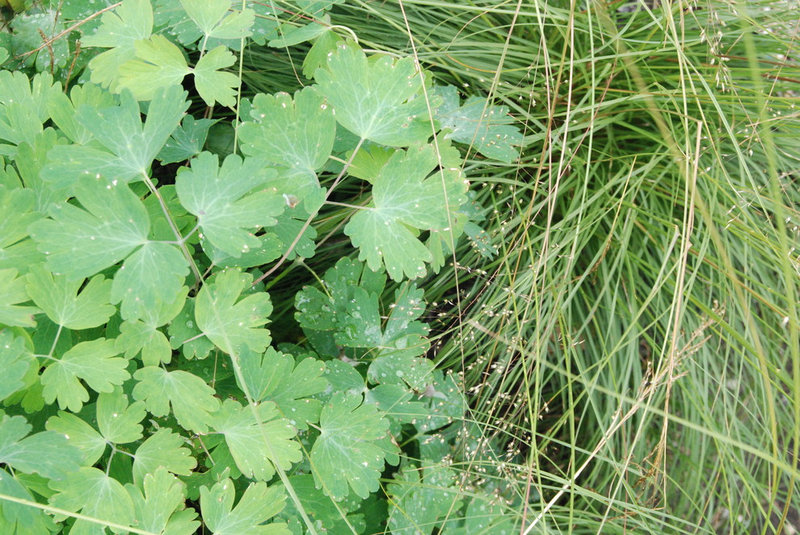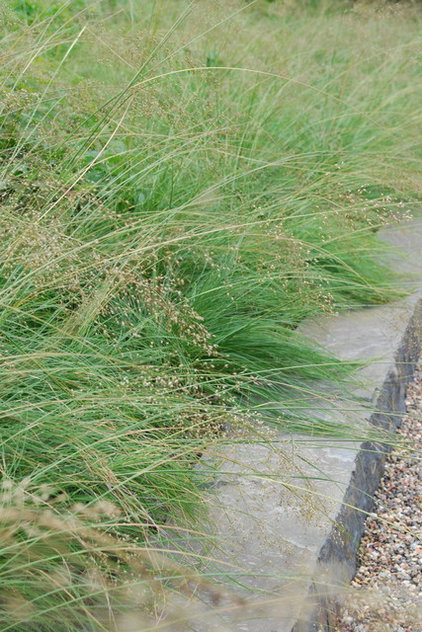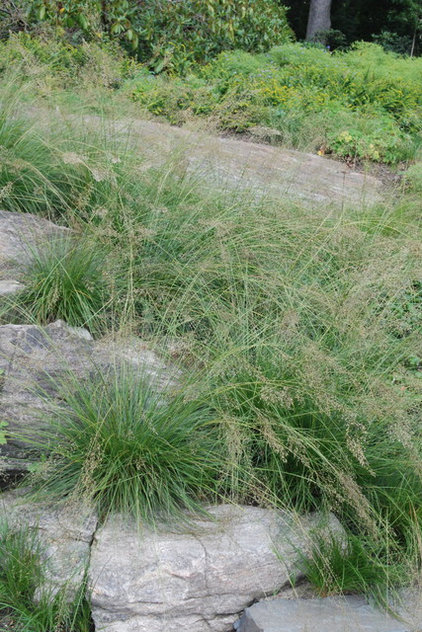If you’re planning a trip to New York City, make sure to see the Native Plant Garden, which opened earlier this year at the New York Botanical Garden. There’s something for everyone here. Shade gardeners will find plenty to look at in the dappled layers beneath a canopy of river birch, dogwood and sugar maple. Farther along the path, beneath an open sky, plants that love sun sprawl in wispy cascades that catch the wind or offer up their blooms in rigid, colorful spikes. And there are places for sitting and listening. In the middle of one of the biggest cities in the world, the sound of bees and birds is very sweet.
Flared pots showcase native plants outside the entrance pavilion — you won’t find geraniums or begonias here. Instead, ornamental grasses welcome you to this state-of-the-art landscape with plants indigenous to eastern North America.
More than 100,000 plants cover this 3½-acre USDA zone 7a location, inspiring anyone looking for ways to develop a sustainable landscape or combine plants in new ways. On a recent visit, I found a new baptisia that I’d like to try — the short purple cultivar ‘Purple Smoke’ (Baptisia australis ‘Purple Smoke’), because I love anything with purple spikes.
Winding paths take you through a woodland and connect to other distinct areas. There’s a glade, wetland, wet meadow, dry meadow, native border and promenade walk that runs along an angular 230-foot-long water feature that cuts through the center of the landscape.
More than 100,000 plants cover this 3½-acre USDA zone 7a location, inspiring anyone looking for ways to develop a sustainable landscape or combine plants in new ways. On a recent visit, I found a new baptisia that I’d like to try — the short purple cultivar ‘Purple Smoke’ (Baptisia australis ‘Purple Smoke’), because I love anything with purple spikes.
Winding paths take you through a woodland and connect to other distinct areas. There’s a glade, wetland, wet meadow, dry meadow, native border and promenade walk that runs along an angular 230-foot-long water feature that cuts through the center of the landscape.
“The whole site is a tribute to the rich, diverse flora of the Northeast,” says principal designer Sheila Brady of Oehme, van Sweden. “We pivoted the design around the geology, all the beautiful rock outcroppings, the wet meadow and the mature forest nearby.”
One of the project goals was to integrate a sustainable water feature. “We capture all the surface runoff in a system that utilizes biofiltration and minimizes potable water usage,” Brady says. Storm water is filtered through plants like sweetflag (Acorus sp) and stored in cisterns belowground.
One of the project goals was to integrate a sustainable water feature. “We capture all the surface runoff in a system that utilizes biofiltration and minimizes potable water usage,” Brady says. Storm water is filtered through plants like sweetflag (Acorus sp) and stored in cisterns belowground.
In the specially designed wetland, a pump recirculates rainwater, moving it through layers of gravel, sand and plant roots that filter and clean the water through this natural biofiltration system.
Slender blue flag iris (Iris prismatica ‘Exeter’), one of only three iris species native to New York, can be found along the boardwalk. If you’ve got wet soil, a pond or stream, you’ll be interested to know that this tough perennial naturally occurs in these types of areas and has a lovely spring bloom.
Slender blue flag iris (Iris prismatica ‘Exeter’), one of only three iris species native to New York, can be found along the boardwalk. If you’ve got wet soil, a pond or stream, you’ll be interested to know that this tough perennial naturally occurs in these types of areas and has a lovely spring bloom.
In the dappled light of the woodland, clumps of wild columbine (Aquelegia canadensis) mingle with prairie dropseed (Sporobolus heterolepis), a delicate grass with wand-like seed heads. Aquilegia canadensis ‘Little Lanterns’, called Canadian columbine, is mixed into the displays and is more intensely colored than the species.
Red Northern lady fern (Athyrium ‘Lady in Red’) forms a ground cover, along with eastern teaberry (Gaultheria procumbens) and Appalachian sedge (Carex appalachica).
Red Northern lady fern (Athyrium ‘Lady in Red’) forms a ground cover, along with eastern teaberry (Gaultheria procumbens) and Appalachian sedge (Carex appalachica).
Prairie dropseed cascades along the edges of walkways and adds a tactile element.
“What really intrigued me was how, even with a simplified plant palette, a very strong sense of place for each habitat area was communicated,” says garden photographer Karen Bussolini.
“What really intrigued me was how, even with a simplified plant palette, a very strong sense of place for each habitat area was communicated,” says garden photographer Karen Bussolini.
Grasses abound on rocky slopes, where they soften the hard contours of boulders.
For Bussolini, who also works as an ecofriendly garden coach in northwestern Connecticut, the plantings are inspirational. “The garden is full of really great plants, any one of which would be an asset in any garden, but here grown in community,” she says. “The patterns of intermingling plants were endlessly fascinating, and I left inspired to try quite a few of them.”
For Bussolini, who also works as an ecofriendly garden coach in northwestern Connecticut, the plantings are inspirational. “The garden is full of really great plants, any one of which would be an asset in any garden, but here grown in community,” she says. “The patterns of intermingling plants were endlessly fascinating, and I left inspired to try quite a few of them.”

